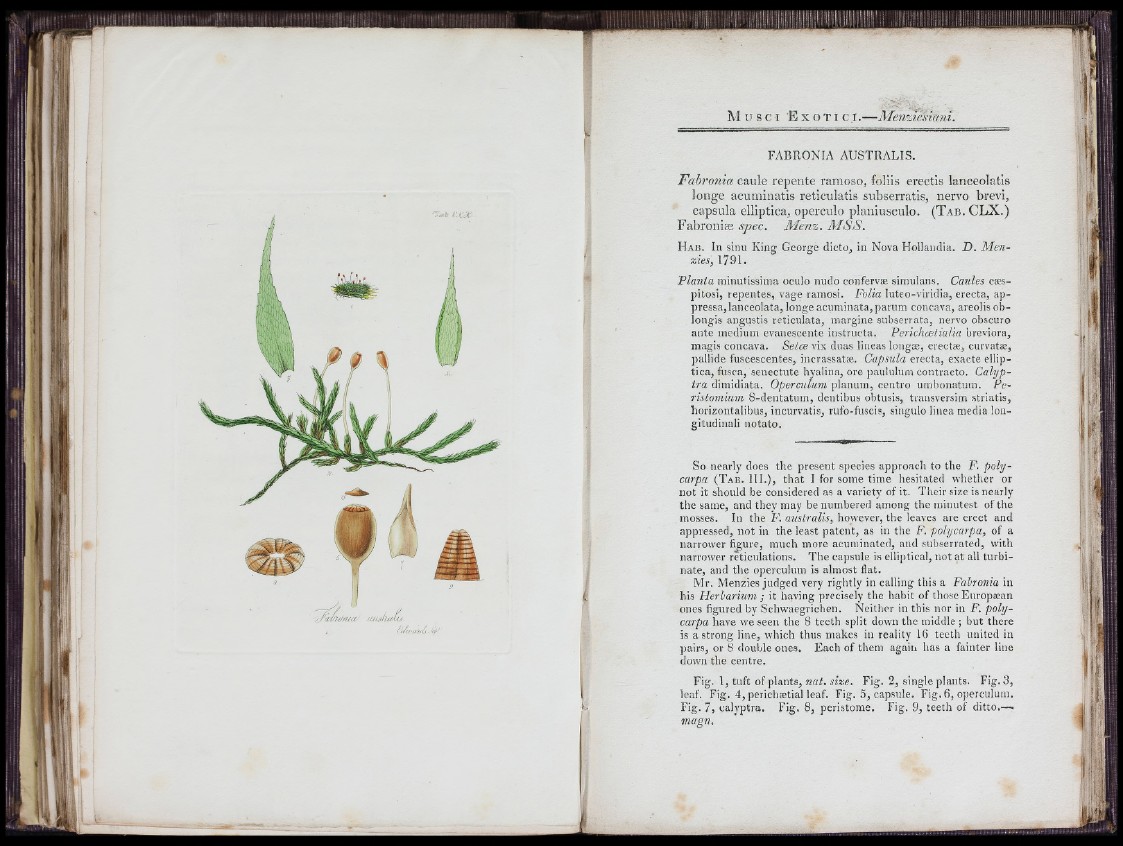
7u,b rjyr
r/'i/Ádmrf luuluié
FABRONIA AUSTRALIS.
Fabronia caule repente ramoso, foliis erectis lanceolatis
longe acuminatis reticulatis subserratis, nervo brevi,
capsula elliptica, operculo planiusculo. (Tab. CLX.)
Fabronias spec. Men%. M S S .
Hab. In sinu King George dicto, in Nova Hollandia. F . Men zies,
1791.
Pianta minutissima oculo nudo confervæ simulans. Caules cæspitosi,
repentes, vage ramosi. C'olia luteo-viridia, erecta, appressa,
lanceolata, longe acuminata, parum concava, areolis oblongis
angiistis reticulata, margine subserrata, nervo obscuro
ante medium evanescente instructa. Perichætialia breviora,
m.agis concava. Setæ vix duas lineas longæ, erectæ, curvatæ,
pallide fuscescentes, incrassatæ. Capsula erecta, exacte ellip-
tica, fusca, senectute hyalina, ore paululum contracto. Calyptra
dimidiata. Operculum planum, centro umbonatum. Peristomium
8-dentatum, dentibus obtusi.s, transversim striatis,
horizontalibus, incurvatis, rufo-fuscis, singulo linea media longitudinali
notato.
So nearly does the present species approach to the F. poly-
carpa (Ta b . 111.), that I for some time hesitated whether or
not it should be considered as a variety of it. Their size is nearly
the same, and they may be numbered among the minutest of the
mosses. In the F'. australis, however, the leaves are erect and
appressed, not in the least patent, as in the F. pohjcarpa, of a
narrower figure, much more acuminated, and subseriated, with
narrower reticulations. The capsule is elliptical, not at all turbinate,
and the operculum is almost flat.
Mr. Menzies judged very rightly in calling this a Fahronia in
his Herbarium ; it having precisely the habit of those Europæan
ones figured by Schwaegrichen. Neither in this nor in F. poly-
carpa have we seen the 8 teeth split down the middle ; but there
is a strong line, which thus makes in reality 16 teeth united in
])airs, or 8 double ones. Each of them again has a fainter line
down the centre.
Fig. I, tuft of plants, nat. size. Fig. 2, single plants. Fig. 3,
leaf. Fig. 4, perichætial leaf. Fig. 5, capsule. Fig. 6, operculum.
Fig. 7, calyptra. Fig. 8, peristome. Fig. 9, teeth of ditto.—
magn.
'I. i f
II